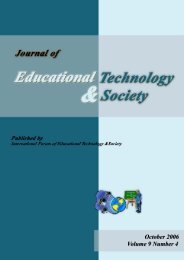Student Engagement: What do we know and what should we do?
Student Engagement: What do we know and what should we do?
Student Engagement: What do we know and what should we do?
Create successful ePaper yourself
Turn your PDF publications into a flip-book with our unique Google optimized e-Paper software.
<strong>and</strong> hotly debated by educators; ho<strong>we</strong>ver, having students use cell phones, IPhones <strong>and</strong><br />
Blackberries <strong>and</strong> other mobile devices for research, collaborative communication, or<br />
social-based learning activities has been shown to increase student engagement by as<br />
much as 78% (Project Tomorrow, 2010, p. 8).<br />
Multimedia <strong>and</strong> technology (cameras, video, <strong>and</strong> video editing, projectors, SmartBoards,<br />
sound recording equipment, animation <strong>and</strong> gaming software, <strong>and</strong> the ubiquitous<br />
Po<strong>we</strong>rPoint) have proven helpful in engaging students in learning about subjects, in<br />
exploring ways to present their learning, <strong>and</strong> more importantly in helping students control<br />
their learning (Dunleavy & Milton, 2009; Barnes, Marateo, & Ferris, 2007; Project<br />
Tomorrow, 2010). Kvavik, Caruso, & Morgan (2004) state, “<strong>Student</strong>s recognize a<br />
number of benefits of classroom IT. Included are convenience, management of classroom<br />
activities, time savings, improved learning, better <strong>and</strong> more effective communications,<br />
<strong>and</strong> better presentation of their class assignments” (p. 12).<br />
In a recent paper titled “Unleashing the Future: Educators “speak up” about the use of<br />
emerging technologies for learning” (2010), teachers report that technology increases<br />
factors of student engagement – including cognitive, affective, behavioral, academic, <strong>and</strong><br />
social engagement. The reported outcomes of increased access to technology in<br />
classrooms mirrors the outcomes of increasing student engagement, such as learners<br />
taking initiative <strong>and</strong> responsibility for their learning, using resources wisely, spending<br />
time on task, <strong>and</strong> having interest <strong>and</strong> desire to pursue information <strong>and</strong> learning both in<br />
<strong>and</strong> beyond the classroom.<br />
As a result of using technology in the classroom, students are more motivated to<br />
learn (51%), apply their <strong>know</strong>ledge to practical problems (30%), <strong>and</strong> take<br />
ownership of their learning (23%). Teachers also report that by using technology,<br />
students are developing key 21 st Century skills including creativity (39%),<br />
collaboration (30%) <strong>and</strong> skills in problem-solving <strong>and</strong> critical thinking (27%).<br />
Furthermore, the learning experience becomes more meaningful for the student as<br />
teachers have newfound time to differentiate instruction (31%) to a greater<br />
degree, <strong>and</strong> have more information to how their students are <strong>do</strong>ing academically<br />
(29%) (Project Tomorrow, 2010, p. 2).<br />
In Celebrating School Improvement (2006), Parsons, McRae, Taylor, Larson & Servage<br />
(2006) report that students in K-12 schools used technology to gather information,<br />
analyze information, <strong>and</strong> share information (pp 110-111). The positive outcomes<br />
included higher achievement <strong>and</strong> quality of work but also, <strong>and</strong> “perhaps more important,<br />
student motivations <strong>and</strong> time spent on task <strong>we</strong>re reported to have increased significantly<br />
with the integration of technology into Alberta’s classrooms” (p. 112). A second element<br />
of “multimedia <strong>and</strong> technology” for improved learner engagement is to create a “rich<br />
learning environment” that allows for cross-curricular, interactive, <strong>and</strong> exploratory<br />
learning.<br />
The term rich learning environment not only includes physical devices, such as<br />
experiment kits or computers, but also the teaching technique, the type of activity<br />
pupils engage in, <strong>and</strong> the method of assessment. Associating science <strong>and</strong><br />
<strong>Student</strong> <strong>Engagement</strong>: <strong>What</strong> <strong>do</strong> <strong>we</strong> <strong>know</strong> <strong>and</strong> <strong>what</strong> <strong>should</strong> <strong>we</strong> <strong>do</strong>? 41












